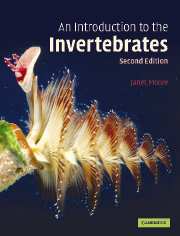Book contents
- Frontmatter
- Contents
- List of boxes
- Preface
- Acknowledgements
- Illustration acknowledgements
- Chapter 1 The process of evolution: natural selection
- Chapter 2 The pattern of evolution: methods of investigation
- Chapter 3 Porifera
- Chapter 4 Cnidaria
- Chapter 5 On being a worm
- Chapter 6 Platyhelminthes and Acoelomorpha
- Chapter 7 Nemertea
- Chapter 8 Nematoda
- Chapter 9 Annelida
- Chapter 10 Mollusca: general and Gastropoda
- Chapter 11 Mollusca: Bivalvia and Cephalopoda
- Chapter 12 Arthropoda: general
- Chapter 13 Crustacea
- Chapter 14 Chelicerata and Myriapoda
- Chapter 15 Insecta
- Chapter 16 Animals with lophophores
- Chapter 17 Echinodermata
- Chapter 18 Invertebrate Chordata and Hemichordata
- Chapter 19 Development
- Chapter 20 Invertebrate evolutionary history
- Further reading
- Glossary
- Index
Chapter 6 - Platyhelminthes and Acoelomorpha
Published online by Cambridge University Press: 05 September 2012
- Frontmatter
- Contents
- List of boxes
- Preface
- Acknowledgements
- Illustration acknowledgements
- Chapter 1 The process of evolution: natural selection
- Chapter 2 The pattern of evolution: methods of investigation
- Chapter 3 Porifera
- Chapter 4 Cnidaria
- Chapter 5 On being a worm
- Chapter 6 Platyhelminthes and Acoelomorpha
- Chapter 7 Nemertea
- Chapter 8 Nematoda
- Chapter 9 Annelida
- Chapter 10 Mollusca: general and Gastropoda
- Chapter 11 Mollusca: Bivalvia and Cephalopoda
- Chapter 12 Arthropoda: general
- Chapter 13 Crustacea
- Chapter 14 Chelicerata and Myriapoda
- Chapter 15 Insecta
- Chapter 16 Animals with lophophores
- Chapter 17 Echinodermata
- Chapter 18 Invertebrate Chordata and Hemichordata
- Chapter 19 Development
- Chapter 20 Invertebrate evolutionary history
- Further reading
- Glossary
- Index
Summary
Platyhelminths and acoelomorphs are two of the simplest groups of animals with three cell layers and bilateral symmetry. When animals are simple in structure we tend to assume that they are primitive, meaning that these animals are representative of early ancestral forms, but this assumption is not necessarily justified: simple animals may have evolved from ancestors more complex than themselves (that is, the simplicity may be secondary), and this can apply to the group as a whole. Simplicity may not be a reliable guide to phylogeny.
Is the simplicity of platyhelminths and acoelomorphs a primitive characteristic or has it been secondarily derived? To answer this question, the following account first describes the body plan of each group and then discusses the main specialisations which have arisen in much the larger group, the platyhelminths. An assessment of relationships is then introduced, to be taken further in Chapter 20 when molecular evidence is discussed.
What is the body plan of the platyhelminths?
The basic structure of platyhelminths is very simple (Figure 6.1). They are ‘triploblastic’, i.e. have three cell layers, outer ectoderm, mesoderm and inner endoderm. In the free-living forms there is an elaborate hermaphrodite reproductive system and an excretory system of ectodermal tubes, the protonephridia (flame cells). Free-living platyhelminths have a head end with anterior sense organs and a rudimentary brain. They move by means of the cilia or by contraction waves in muscle working against fluid pressure of the body contents (gut, parenchyma, genitalia etc.).
- Type
- Chapter
- Information
- An Introduction to the Invertebrates , pp. 65 - 74Publisher: Cambridge University PressPrint publication year: 2006



